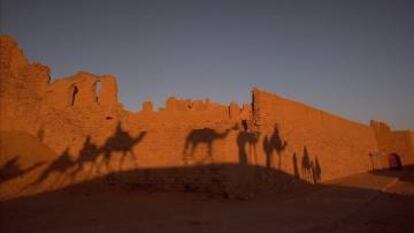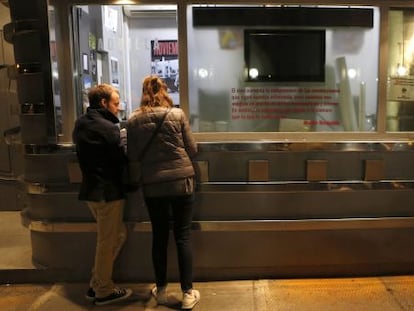Spain’s documentary scene is booming, but is anyone watching?
Some 75 films covering a wide range of subjects were released in cinemas last year, but few caught the attention of audiences

Spanish cinema enjoyed a bumper year in 2015, with 188 films gaining a general release, the largest number ever, according to the Spanish Cinema Yearbook. Perhaps more significant is that 75 of these movies were documentaries. Sadly, few of them were widely seen. The top documentary on the 2015 box office hit list comes in at number 60: Messi. And while this was given a general release, it was hardly what the film’s distributor, Avalon, had expected, given the fame of its director, Álex de la Iglesia, and the appeal of the Barcelona FC soccer star. Compared to other titles handled by Avalon, such as Citizenfour and Searching for Sugarman, the number of people who saw it at the cinema, 3,042, was a big disappointment. “We were expecting more, particularly in Catalonia,” says Avalon’s chief buyer, Enrique Costa.
Spanish filmmakers are still wary of challenging institutions, says film critic Mirito Torreiro
Over the last decade, 734 documentaries have been registered with the Culture Ministry, 109 of them in the last year, says Spain’s Institute for Cinematography and the Audiovisual Arts (ICAA). But it points out that only 32% of them were screened in cinemas.
Mirito Torreiro, a university lecturer, film critic and one of the organizers of the documentary section of the annual Malaga Film Festival, says that in general terms, the quality of Spanish documentaries has improved. That said, he believes Spanish filmmakers are still wary of challenging institutions, that few directors are still confident enough to make films based on their own experiences and that there is a problem marketing these kinds of films.
One of the most influential Spanish documentaries of recent years is Ciutat Morta (Dead City), by Xavier Artigas and Xapo Ortega, which won the Best Documentary at the 2014 Malaga Film Festival. Only 3,000 people saw it at the cinema, but it was subsequently aired on Catalan regional television in January 2015, 18 months after it was released, making a huge impact: it was seen by 528,000 people, giving it a 19% audience share. The documentary was then posted on YouTube, where it has since racked up half-a-million hits.
The most popular documentaries of the decade
El misterio del Nilo (The mystery of the Nile) (2005) by Jordi Llompart. One of the most popular films in IMAX theaters, seen by 450,000 people.
Océanos (Oceans) (2009) by Jacques Perrin and Jacques Cluzaud. Spain was part of the production team for this nature documentary that sold 201,720 tickets.
La última cima (The Last Summit) (2010) by Juan Manuel Cotelo. A documentary on the death of a priest that drew audiences of 136,000.
Tierra de María (Maria's land) (2013), also by Cotelo and also religious, appealing to 59,000 moviegoers.
Ciutat Morta looks at the events of the night of February 4, 2006 in Barcelona’s old quarter, when police attempted to break up a party being held in a squat in an empty building owned by City Hall. In the ensuing fracas, a police officer was hit by an object thrown from the roof, leaving him paraplegic.
Seven people were arrested, a number of whom ended up in hospital, where a young woman and her boyfriend who had been injured in a bicycle accident were also being treated. They were then detained for their alleged involvement in the violence at the squat, a charge they both denied. They were subsequently convicted and sent to prison. The young woman, Patricia Heras, committed suicide soon after she was released.
At the other end of the extreme is the prize-winning Queridos Monstruos (Dear Monsters), a history of the last 50 years of Spanish horror films. “We knew it wouldn’t do well at the box office,” says director Kiko Prada. “If independent films have a small chance of success, then an independent documentary’s chances are minuscule. This was the sort of film that should be shown on television: that way it would have reached more people.”
Sign up for our newsletter
EL PAÍS English Edition has launched a weekly newsletter. Sign up today to receive a selection of our best stories in your inbox every Saturday morning. For full details about how to subscribe, click here
Meanwhile, Sueños de Sal (Salt Dreams), managed to find an audience before winning a Goya, Spain’s equivalent of the Oscars. “When your expectations are low, you’re pleased with any result,” says producer Jesús Navarro, who worked hard to find ways to bring it to the public. “We showed it in small theaters that had been closed until then,” he says. Using this town-by-town strategy, the film was seen by 1,735 people, with all proceeds going to the Red Cross and Catholic Church charity Cáritas.
Josetxo Cerdán, the former artistic director of the Punto de Vista documentary festival held in Pamplona each February, says that Spanish filmmakers need to start thinking about how to reach larger, international audiences, particularly in Latin America by making documentaries with wider appeal: “The reality of Spain may be reflected on the screen, but does the movie reach out to people?”
English version by Heather Galloway.
Television: the salvation and ruin of the sector

Spanish documentaries depend heavily on the country’s national and regional television stations for funding and a screening. In the past decade, state broadcaster TVE has been behind 121 documentaries, Valencia’s TV3 has backed 93, while Basque regional broadcaster ETB has funded 39 and Canal Plus, 25. The remaining stations have supported 41. The cable and pay-per-view channels rarely fund documentaries.
But without television, there’s no way documentaries will be made in Spain, say directors and producers, at the same time asking whether we can we expect state television, which relies on public money, to tackle sensitive political issues.
Tu suscripción se está usando en otro dispositivo
¿Quieres añadir otro usuario a tu suscripción?
Si continúas leyendo en este dispositivo, no se podrá leer en el otro.
FlechaTu suscripción se está usando en otro dispositivo y solo puedes acceder a EL PAÍS desde un dispositivo a la vez.
Si quieres compartir tu cuenta, cambia tu suscripción a la modalidad Premium, así podrás añadir otro usuario. Cada uno accederá con su propia cuenta de email, lo que os permitirá personalizar vuestra experiencia en EL PAÍS.
¿Tienes una suscripción de empresa? Accede aquí para contratar más cuentas.
En el caso de no saber quién está usando tu cuenta, te recomendamos cambiar tu contraseña aquí.
Si decides continuar compartiendo tu cuenta, este mensaje se mostrará en tu dispositivo y en el de la otra persona que está usando tu cuenta de forma indefinida, afectando a tu experiencia de lectura. Puedes consultar aquí los términos y condiciones de la suscripción digital.
More information
Últimas noticias
The complicated life of Francesca Albanese: A rising figure in Italy but barred from every bank by Trump’s sanctions
From digital curfews to blocking apps: How technology experts protect their children online
Why the price of coffee has skyrocketed: from Brazilian plantations to specialty coffee houses
Confined to a Cuban hospital: When electricity is a matter of life or death
Most viewed
- Pablo Escobar’s hippos: A serious environmental problem, 40 years on
- Why we lost the habit of sleeping in two segments and how that changed our sense of time
- Trump’s obsession with putting his name on everything is unprecedented in the United States
- The Florida Keys tourist paradise is besieged by immigration agents: ‘We’ve never seen anything like this’
- Charles Dubouloz, mountaineering star, retires at 36 with a farewell tour inspired by Walter Bonatti










































